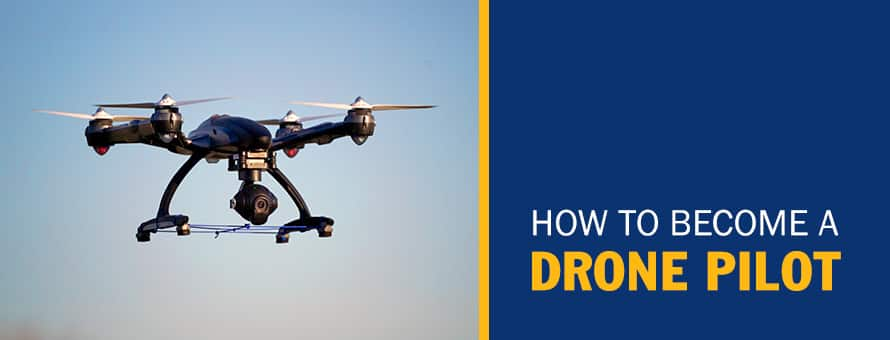What is a Drone and Do you Need a License to Fly One?

Understanding the numbers
When reviewing job growth and salary information, it’s important to remember that actual numbers can vary due to many different factors—like years of experience in the role, industry of employment, geographic location, worker skill and economic conditions. Cited projections are based on Bureau of Labor Statistics data, not on SNHU graduate outcomes, and do not guarantee actual salary or job growth.
Drones – or unmanned aerial systems – can be flown for commercial, public safety, recreational and educational reasons. Although they're flown by operators who never leave the ground themselves, drones still must adhere to the rules and regulations set by the Federal Aviation Administration (FAA).
To become a drone pilot, you must earn a Remote Pilot Certificate that demonstrates your understanding of the regulations, operating requirements and procedures for safely flying drones, according to the FAA. In other words, just as you would need a license to drive a car, boat or plane, you also need a license to fly a drone.
What is the Difference Between a Drone, UAV and UAS?
Depending on what publication you are reading, you may see drones referred to as either UAS (unmanned aerial systems) or UAV (unmanned aerial vehicles). The FAA frequently uses the term UAV to refer to drones, while most mainstream media outlets simply use the term drone, according to Business News Daily.
UAS is a broader term that describes more than just the aircraft. UAS refers to the whole drone system, including its steering system and the pilot who operates it. The FAA uses UAV as the official term for what commercial drone pilots fly, according to the same article.
What Are Drones Used For Today?
Not only do drones help keep us safe, but they also can be used in a variety of commercial applications. Here are some other ways you can make money with a drone:
- Express delivery services – In October 2019, United Parcel Service, Inc. made its first medical delivery by drone. A few weeks ago, the FAA proposed new safety standards for specific drones for package deliveries in the Federal Register, opening the door for routine package deliveries by drones in the near future.
- Aerial photography for real estate companies – Brokers can now get spectacular shots of buildings and neighborhoods from far above. You can buy drones fairly cheaply to take high-quality images and video for a variety of uses.
- Help search and rescue missions – Drones can be deployed to locate people in areas ravaged by fire, flood or other natural disaster. In 2017, an estimated 65 people were rescued with the assistance of drone technology. By June of 2018, that number skyrocketed to 133 people, according to DJI. If they are equipped with sensors, drones can locate humans in remote areas by their heat signatures, for example, according to DronZon.
- Insurance claims – Drones can document land and building damage or gather pictures from an accident scene.
How to Get a Drone License
Until 2016, any commercial businessperson flying a drone — from real estate agents to farmers to photographers — had to have a pilot's license. In August 2016, the FAA passed UAS Rule Part 107, a new set of rules governing the usage of drones weighing under 55 pounds for commercial purposes. In lieu of a pilot’s license, the FAA now requires that you earn a “Remote Pilot Certificate,” which can be obtained by passing an aeronautical knowledge test. This certificate demonstrates that you understand the regulations, operating requirements and procedures for safely flying drones, according to the FAA.
To be eligible for a drone license, you must:
- Be at least 16-years-old
- Be able to read, speak, understand and write English
- Be in a physical and mental condition to safely fly a drone
- Pass the initial aeronautical knowledge exam
Drone pilots can become licensed if they are able to demonstrate proficiency on the initial aeronautical knowledge exam. The exam is comprised of 60 multiple-choice questions and covers topics such as:
- Regulations relating to small UAS rating privileges, limitations and flight operation
- Aviation weather sources and effects of weather on small UAS performance
- Emergency procedures
- Radio communication procedures
- Aeronautical decision-making and judgment
- Airport operations
- Maintenance and pre-flight inspection procedures
If you get caught flying a drone without a license, you could receive a $1,100 fine from the FAA.
How to Prepare for Your Drone License
 Before you launch your drone into the sky, you'll want to make sure you're following all of the Part 107 rules. You’ll also need to pick and register your drone — as well as understand how to fly it in multiple scenarios.
Before you launch your drone into the sky, you'll want to make sure you're following all of the Part 107 rules. You’ll also need to pick and register your drone — as well as understand how to fly it in multiple scenarios.
Students can learn how to fly a drone and prepare for their exam and Remote Pilot Certificate on their own or through structured programs, such as the UAS Certificate Program offered at Southern New Hampshire University (SNHU).
In the program, students gain an understanding of UAS regulations, flight operations, crew resource management, risk management and mitigation, airspace requirements, and emergency operations. The final part of the program includes planning and executing a drone mission, said Kyle Viator, assistant dean of academics at SNHU's College for Engineering, Technology and Aeronautics (CETA).
The UAS Certificate, launched last year in response to the increasing popularity of commercial drones and changing legislation, was developed in partnership with ArgenTech Solutions and endorsed by the New Hampshire Department of Transportation. Completing the program also results in a Remote Pilot Certificate, Viator said.
However, students do take the Part 107 exam at the end of their first class, and so far, the program boasts a 100% pass rate, Viator said. The UAS Certificate may be added on to an aviation degree program or pursued on its own. (The university already offers bachelor’s degrees in Aeronautical Engineering, Air Traffic Management, and Aviation Operations and Management.)
“The laws are changing pretty quickly. Amazon has been in news a lot related to drones. There was an article published a few weeks ago that reported on a drone that had really caused chaos at an airport,” Viator said. “The FAA is in a position where they are scrambling to create new legislation. We are looking to stay ahead of it.”
Students pursuing the UAS Certificate and licensure are eager to add new credentials to their resumes and expand their ability to use drone technology in business and industry. The new CETA building allows students to fly drones inside; although they get plenty of time to test and execute missions on the campus athletic fields as well, Viator said.
Drone Pilot Jobs
Novice drone pilots looking to hone their aviation skills for commercial purposes should look for programs that offer real-world experiences in addition to a path to certification.
“We give them the ability to find jobs and internships in corporate flight operations and mission planning for drones and build that into the latter half of the certificate program,” Viator said.
Whether you plan on flying your drone to broaden your aviation skill set or embark on a new career, you need the right mix of education and flying aptitude to earn your license and Remote Pilot Certificate. Finding the right preparation program can help you launch your drone with confidence.
Krysten Godfrey Maddocks ’11G is a writer who covers K-12 and higher education topics, including policy and the role of digital technology in education. She spent almost a decade working in various marketing roles at an educational assessment company before launching a strategic marketing company. Maddocks earned a master's degree in marketing from Southern New Hampshire University and a bachelor's degree in English/ journalism from the University of New Hampshire. Connect with her on LinkedIn.
Explore more content like this article

How to Learn Artificial Intelligence (Plus Helpful Courses and Skills)

Telling Stories With Numbers: How to Become a Data Analyst

How SNHU Grad Cyndie Ramirez Built Her Second Career in Cybersecurity
About Southern New Hampshire University

SNHU is a nonprofit, accredited university with a mission to make high-quality education more accessible and affordable for everyone.
Founded in 1932, and online since 1995, we’ve helped countless students reach their goals with flexible, career-focused programs. Our 300-acre campus in Manchester, NH is home to over 3,000 students, and we serve over 135,000 students online. Visit our about SNHU page to learn more about our mission, accreditations, leadership team, national recognitions and awards.


